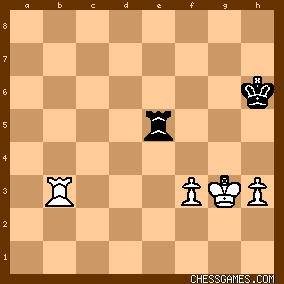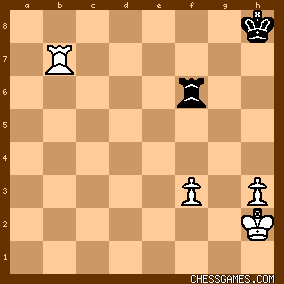| Nov-06-11 | | DAVI DE RAFE: should resign at 52 atleast- |
|
Nov-06-11
 | | tamar: Svidler was hoping for 53 Kg3 Kxh6 which is a draw despite the two pawn deficit. 
click for larger view |
|
| Nov-06-11 | | hedgeh0g: Watching this game live, I was amazed at how Svidler managed to produce drawing chances out of what I felt certain was a lost middlegame. 52...Kh7? is inexplicable to me, since it allows White to keep all his pawns. 52...Rh5 recoups a crucial pawn and gives Black some chances to hold in the f+h-pawn ending. Admittedly, it looks grim after 53.Kg3 Rxh6 54.Rb7, but this variation was a better try, in my opinion. |
|
| Nov-06-11 | | GilesFarnaby: For those wandering how to defend:
1: Veselin Topalov - Peter Svidler, European Team Championship 2011

click for larger viewAnalysis by Houdini 2.0 Pro w32:
53.Kg3 Rxh6 54.Rb8+ Kg7 55.Rb7+ Kh8 56.h4 Rg6+ 57.Kh3 Rg8 58.f4 Rg1 59.h5 Kg8 60.Rc7 Kh8 61.Kh4 Kg8 62.Re7 Kf8 63.Rb7 Rg2 64.f5 Kg8 65.Ra7 Rg1 66.f6 Rf1 67.Kg5 Rg1+ 68.Kf4 Rf1+ 69.Ke5 Re1+ 70.Kf5 Rf1+ 71.Kg6 Rg1+ 72.Kh6 Kf8 73.Kh7 Rf1 74.Kg6 Rg1+ 75.Kf5 Rf1+ 76.Ke6 Re1+ 77.Kd5 Rd1+ 78.Ke5 Re1+ 79.Kf4 Rh1 80.Kg5 Rg1+ 81.Kh6 Rg2 82.Kh7 Rf2 83.Kg6 Rg2+ 84.Kf5 Rf2+ 85.Kg5 Rg2+ 86.Kf4 Rf2+ 87.Ke5 Re2+ 88.Kd5 Rd2+ 89.Ke5 Re2+ 90.Kd5
 (1.77) Depth: 41/116 00:07:18 915mN (1.77) Depth: 41/116 00:07:18 915mN
(Farnaby, Giles . 07.11.2011)
It would have been also possible with 52...Rd6. The key is not to lose the K opposition, of course, and aim for a the Philidor position since no "bridge" will be available for white between the f and h pawns. Surely ...Kh7 looks mysterious when regarded from home, but sometimes after <4 hrs. of play every move starts looking the same as your mood. |
|
Nov-06-11
 | | tamar: Topalov speaks briefly about this game http://www.chessdom.com/interview-w... "He missed to play rook ending h and f pawns which is supposed to be drawn." |
|
Nov-06-11
 | | tamar: <GilesFarnaby> Did Svidler really miss a draw though? From your diagram, tablebases show a win after 53 Kg3 Rxh6 with a win in 40 moves 54 Rb8+ It diverges from Houdini's analysis at move 66 f6 when it declares a draw. It gives as winning 66 h6 Rf1 67 Kg5 Rg1+ 68 Kf6 Rb1 69 Rae7 Ra1 70 Ke5 Re1+ 71 Kd6 Rd1+ 72 Ke6 Re1+ 73 Kd7 Rd1+ 74 Ke8 Rf1 75 Re5 Kh7 76 Kf7 Ra1 77 Re6 Ra8 78 Re8 Ra6 79 Re3 Rb6 80 Re2 Rb7+ 81 Re2 Rb7+ 81 Ke8 Kxh6 82 Re6+ Kh7 83 f6 and White has obtained the winning formation. I would speculate that 66 f6 draws instead of 66 h6 because the King needs that square to finally get to e8 |
|
Nov-06-11
 | | tamar: Now I see. Only 52...Rd6 holds the draw.
The difference between 52...Rd6 and 52...Rh5 is that Black threatens to take h6 with the King after 53 Kg3 Kh7 (not 53...Rxh6 which transposes into the tablebase loss after 54 Rb8+) This threat to take with the King forces White to lose a tempo with 53 Rb7 Rxh6 54 Kg3 Rg6+ when the King cannot advance and keep guard on both pawns. I am thinking that Svidler was seeing this line and played ...Kh7 a move too early. |
|
| Nov-06-11 | | GilesFarnaby: <tamar:...>
You are absolutely right; I was so convinced that it was a draw that I didn't bother checking the tablebase! I heard Topalov, in the video you posted, saying that Svidler missed a draw (but it was not with the aforementioned ...Rh5 that could be achieved), and a similar position (f and h pawns + R against R) arose in a Kramnik - Aronian game some years ago and according to the Russian GM it was a draw, so the difference, now, is maybe is that the white rook cuts, in the 7th rank, the black K mobility and also threatens checkmate if the white K is in g6 or near that square... Anyway, tablebase checked now, the 52...Rd6 I suggested does lead to a draw, the difference being that after that move Rb8+ or Rb7 would not be so useful since the black K can roam along the h file to try to grab the pawn (after Rb7 Rxh6 Kg3 Rg6+ Kh2 Rf6 and now white has either to repeat moves or bring down the rook from b7 to b3 to protect the f pawn) So, this is a draw (white to move):

click for larger viewAnd this is a draw also (black to move):

click for larger viewBut this is winning for white (white to move):

click for larger view...As long as white plays Rb8+, which according to the tableblase is the only winning move. |
|
Nov-06-11
 | | tamar: <GilesFarnaby> Yes when you see so many only moves in a tablebase ending, it tells you it is very difficult over the board. Topalov didn't sound too sure he knew how it was done. |
|
| Nov-06-11 | | hedgeh0g: I'm sure Topalov got a little flustered when he realised he'd been duped into this ending. Even so, the defence is hardly trivial, even for a player of Svidler's calibre. |
|
Nov-06-11
 | | plang: I am sure, as a practical matter, the draw is not so easy tablebase or not. |
|
| Nov-06-11 | | SimonWebbsTiger: It is always fascinating to see such analysis of a practical endgame because theory has a few stock positions and advice in classic works such as <Levenfish and Smyslov>. <The Encyclopedia of Chess Endgames> has a plethora of these positions and it is amazing to see how small changes in the positioning of the rooks and pawns decide a win or draw. Of course, such works are "out of date" now we have computers sufficiently strong to work out the multitude of positions but that really is no help to the practical player who isn't going to learn them because of the impossibility or need to do so. Did Nunn analyse other types in his book on rook endgames or is it just a complete computer analysis of R+P v. R? A link that might be of interest is to Karsten Mueller at chessbase who looked at another example of R+rook pawn and bishop pawn v. R
http://www.chessbase.com/newsdetail... |
|
| Nov-07-11 | | Riverbeast: Wow great game from Topalov
If Svidler had any possible draw, it was tablebase and difficult Topalov really outplayed him from start to finish, I thought |
|
| Nov-07-11 | | bronkenstein: <Qc2!?>(different line, but same place as in famous `Re2!!` game - Kamsky vs Svidler, 2011 ) , Kamsky lets Svidler off the hook only by making mistakes later in a very complicated midgame. Topa prolly studied ideas of his `predecessor` , and was bit more precise in execution. |
|
| Nov-07-11 | | xanadu: I do not understand the plan of Svidler in the middle game. For instance:why 11...Bc5, leaving the castle without the protection of the Bishop? If the idea was to liberate the e-column for advancing the d-pawn defending e5 with the rook, then I should say that this plan has many drawbacks. First, it requires many movements of Bishop and pawns before completing development (connection of rooks). Second, to open the position, as Topalov already did, is in the favor of White because is advanced in development and space, and can easily transport pieces from center to the side for attacking Black´s Castle. I think this was what it happened in this game. |
|
| Nov-07-11 | | xanadu: Thus,I agree with bronkenstein in that Kamsky lost the advantage (making mistakes, there is no other way...) in his game with Svidler. Topalov prepared the revenge! |
|
| Nov-07-11 | | Ulhumbrus: One justification for 17...c5 instead of 17...Qd6 is that on 18 b4 the withdrawal Nc6 won't then obstruct the c7 pawn |
|
| Nov-08-11 | | xanadu: Hi Uhlumbrus: after 17...c5: why it is necessary to play 18b4? Why not to take the e-pawn? Regards, Xanadu |
|
| Nov-09-11 | | Ulhumbrus: <xanadu: Hi Uhlumbrus: after 17...c5: why it is necessary to play 18b4? Why not to take the e-pawn? Regards, Xanadu> This suggests that after 16...Na5 Black lacks time to play ...c5. On the other hand, 16 Qb3 attacks the N on d5 a second time. This suggests preparing the advance ...d5 eg by 14...Qd7 so that after eg 15 Ng3 d5 16 exd5 Nxd5 17 Qb3 Black can defend the N on d5 by 17...Rad8 instead of playing ...Na5. Another alternative to 14...d5 is the manoeuvre 14...Ne7 followed by ...Ng6 |
|
| Nov-10-11 | | xanadu: Ok, I see, thanks. Then, the Black position was not ready for advancing d5 in move 14... because the possibility of supporting that with the rooks was not yet prepared (as it is indeed in the variant you propose). |
|
| Nov-10-11 | | xanadu: I am then back to my first comment: the Black strategy is justified if and only if can prepare d5 properly. But this takes time. If Whithe do not remains quiet on the King side, the plan of Black will be difficult to apply at this high level. |
|
Jan-03-12
 | | Penguincw: White, already up 3 pawns turns it into an easy "1". |
|





































